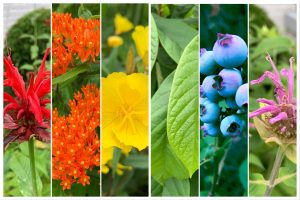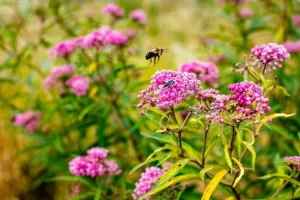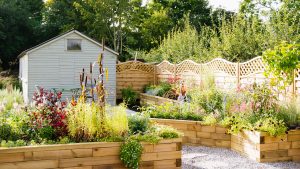Gardening has always been a rewarding and fulfilling hobby. It allows you to connect with nature, beautify your surroundings, and even make a positive contribution to the environment. A special trend that is rapidly emerging is the design of native botanical gardens. Native botanical gardens are not only beautiful but also ecologically responsible. In this article, we explore the benefits of native plant gardens and give you basic tips for designing your own gardens.
The Beauty of Native Plants
Native plants are plants that occur naturally in a specific area and develop and adapt to the local climate, soil, and nature over thousands of years. Including native plants in your garden can provide many benefits:
- Low Maintenance: Native plants are well suited to their local environment, meaning they require less water, fertilizers, and pesticides than exotic species. Once established, they thrive with minimal intervention, saving you time and energy.
- Wildlife friendly: Native plants provide habitat and food for local wildlife, including birds, butterflies, and bees. By planting native plants, you can create a mini ecosystem in your backyard that supports biodiversity.
- Water conservation: Many native plants have deep roots, which help prevent soil erosion and improve water retention. They are an excellent choice for landscaping in dry areas.
- Seasonal Beauty: Native gardens can be designed to bloom all year round, ensuring your garden is a visual delight in any season. From wildflowers in spring to the colorful leaves of autumn, you’ll have something to enjoy all year round.
Design your Native Plant Garden
Now that you understand the benefits, let’s discuss how to design your native plant garden:
- Research native plants: Start by identifying native plants that grow naturally in your area. Visit a local nursery or consult an expert who can recommend suitable varieties. When making your choice, consider factors such as soil type, sunlight, and moisture.
- Diversity plan: A successful native garden should contain a variety of plant species. This diversity not only looks visually appealing but also attracts a wider range of wildlife. Mix flowers, shrubs, and trees to create different layers and textures.
- Group plants wisely: Divide plants into groups with similar water and sunlight needs. This helps optimize irrigation and maintenance and ensures each plant thrives in the desired conditions.
- Mulch and Weed Control: Apply mulch to retain moisture, suppress weeds, and improve soil quality. It also mimics a natural forest floor, which is beneficial for many native species.
- Patience is key: it can take a year or two for a native plant garden to be fully established. Be patient during this time and resist the urge to overwater or overfertilize. Once established, they will reward you with their beauty and low maintenance requirements.
Maintain your Native Plant Garden
Once you’ve designed your native plant garden, it’s important to know how to maintain it so that it continues to bloom and look its best. Here are some basic maintenance tips:
- Pruning and pruning: Regular pruning and pruning is necessary to keep native plants healthy and tidy. Remove dead or diseased branches, wilted flowers, and any overgrowth that could hinder the growth of neighboring plants. Pruning should be done during the dormant season or when the plant is not actively growing.
- Water Wisely: Although native plants are generally more drought tolerant than exotic species, they still need some water, especially during their growth stages. Water deeply but infrequently to promote deep root growth and resistance to dry conditions. Use a water hose or drip irrigation to deliver water directly to the root zone, minimizing waste.
- Weeding: Regular weeding is essential to prevent invasive, non-native plants from taking over your garden. Pull weeds by hand to avoid disturbing the roots of the native plant, and consider using organic mulch to further suppress weed growth.
- Pest and disease control: Native plant gardens are less susceptible to pests and diseases than exotic plant gardens. However, you should still watch out for common garden pests such as aphids or caterpillars. Consider using natural, non-toxic methods to control pests, such as introducing beneficial insects or using neem oil.
- Seasonal Maintenance: Different seasons require different types of maintenance. Check for signs of new growth in spring and prune accordingly. Monitor your watering schedule during the summer to ensure your plants get enough moisture during hot, dry periods. In the fall, clear away clutter and fallen leaves to prepare your garden for winter. Winter maintenance may include protecting sensitive plants from frost or snow.
Share your Birth Garden
One of the joys of having a native plant garden is sharing its beauty and benefits with others. Here are some ideas for sharing your garden with the community:
- Garden Tours: Organize open garden tours or attend local garden tours and events. Not only does this show off your hard work, but it also educates others about the benefits of native plant gardening.
- Workshops and classes: Organize workshops or classes on native plant gardening. Educate your neighbors and friends about the importance of native plants, their care, and their impact on local ecosystems.
- Online Presence: Share your native garden journey via social media, blog, or website. Document your garden’s progress, share gardening tips, and connect with like-minded people who share your passion for native plants.
Conclusion
In summary, designing and maintaining a native plant garden is a rewarding endeavor that not only improves your environment but also makes a positive contribution to the environment. With proper planning and care, your garden can flourish, providing you with an oasis of natural beauty and becoming a valuable habitat for local wildlife. So start growing your native plant garden today and enjoy the benefits it can bring to your life and community.
FAQs
1. What is a native plant garden?
A native botanical garden is a garden that mainly contains plant species that originate from a specific area. These plants occur naturally in local ecosystems and have adapted over time to the local climate, soil, and nature.
2. Are native plants drought tolerant?
Many native plants are indeed drought tolerant. They have adapted to local conditions and often have deep root systems that allow them to absorb moisture even during periods of drought. However, it is worth noting that not all native plants are drought tolerant, so it is crucial to choose species that are compatible with the amount of water available in your garden.
3. Can I create a native plant garden in a small space or container garden?
Yes, you can create a native plant garden or even a container garden in a small space. Many native plants are suitable for small gardens or container gardening, making it possible to enjoy the benefits of native plants in a limited space.
4. How can I share my love of gardening native plants with others?
You can share your passion for gardening native plants by organizing garden tours, workshops and classes and having an online presence through social media or blogging. These events help educate and inspire others to embrace native plant gardening and its benefits.



